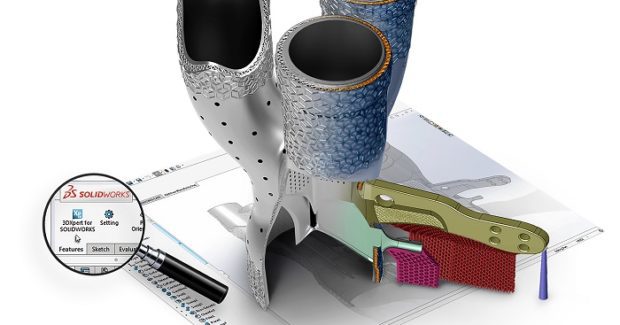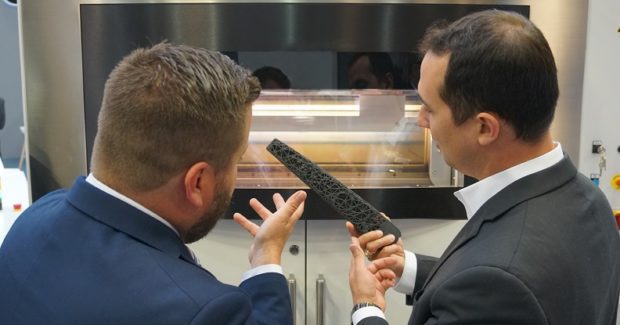Reimagined Parts: Additive Manufacturing Takes Center Stage (Part One)
Additive manufacturing is moving beyond prototypes, part repair and producing non-critical parts, and entering the direct production of critical parts and lot sizes. To deliver these jobs quicker, digital networks are integrating AM with product design software, CAD/CAM, ERP and automation to develop new approaches that can build innovative products faster than ever.
Posted: July 15, 2019
Keeping up with the fast-changing state of additive manufacturing (AM) technology is like putting together a jigsaw puzzle as new pieces are discovered. Each player presents a new piece of the puzzle that promises to solve problems and reduce the costs of high-mix/low-volume parts manufacturing. At the same time, adopters in various industries want answers on everything ranging from the basic choice of a material to how to accurately analyze properties on a molecular level. In the middle of all this disruption, one thing is certain: When the cost per part of AM goes down, new markets open up as more shops recognize how they can manage special requests from their customers, respond faster by eliminating the need to produce tooling and do it all without disrupting their primary production capacity. For example, new micro-AM technology can now mass manufacture at micron-level resolution to meet the exacting precision and resolution required in micro manufacturing. This is very appealing to manufacturers who could not cost-effectively fulfil design intent by using traditional manufacturing processes:
True Disruption: 3D Printing Micro Components
Until this micro-AM technology was introduced, the requirements for ultra-precision, repeatable resolution and surface finish from the micro-manufacturing sector were impossible to achieve through the use of 3D printing.
Because the United States lost about 37 percent of their die and tool industry in less than a decade and currently imports 70 percent to 80 percent of their tools, one of the fastest growing segments for both polymer-based and metal-based AM is the creation of jigs, fixtures and other job aids that reduce cost and time-to-market.1 In a snapshot, AM has moved from prototyping to building jigs and fixtures and now to volume production of end parts – a recommended path of technology adoption that helps shops become familiar with AM in digestible increments. As they move forward, they must invest in AM-specific software. “Originally, machines, materials and CAD/CAM software were made for prototyping,” stated Duann Scott, the director of business development and strategy for additive at Autodesk Inc. (San Rafael, CA). “Now we need tools that are more robust to produce desirable, repeatable parts.”1
Scott explained how ‘AM’ is an umbrella term for many different technologies, and each technology has its own problems to solve, which can be a challenge for a newcomer trying to swim through the ocean of AM technologies – directed energy deposition (DED), fused filament fabrication (FFF), digital light printing (DLP), laser powder bed fusion, selective laser melting (SLM), selective laser sintering (SLS), laminated object manufacturing (LOM) with diffusion bonding – and select the one that fits their business for competitive advantage. One of the issues that many users of AM grapple with is that they don’t understand what happens during the build process, and that induces more trial and error time. “In metal printing, we see a lot of thermal distortion in the parts from the energy directed to the powder,” noted Scott. “The proper software can simulate the build process and look for distortion, compensate and create successful prints for those parts.” 1
References
- “IMTS 2018: The Industry’s Greatest Gathering of Resources for Additive Manufacturing,” AMT – The Association for Manufacturing Technology, July 9, 2018, www.AMTonline.org.
For 3D printing, small and medium-sized runs are typically cost effective and essentially represent a sweet spot for AM technology. But when you add into the mix how it also allows for mass customization, personalization and the ability to use the same manufacturing platform for prototyping, small batches and mass manufacturing, you begin to see the myriad of possibilities that now exist for shops of all sizes to reimagine how they make parts for their customers. For a better perspective, take a closer look at some of the innovations taking place in the fast-paced world of additive manufacturing:
Using Toolpath Simulation for Faster Build Rates of Extreme Complexity
BeAM uses software from CGTech to verify millions of lines of code used to drive their high-speed, five-axis powder-based directed energy deposition additive systems, creating a layer of machine protection and simulation accuracy otherwise impossible to achieve.
3D Printing Beyond Big on a Smaller Budget
Starting at under $200K, the WorkCenter 500 large format 3D printer from 3DP provides users with an extra-large format and affordability without sacrificing build volume quality or throughput.
Scalable 3D Printing Systems Meet Evolving Business Demands
Modular production platforms from 3D Systems help shops evolve and grow by accelerating their time-to-market with ultra-fast production of highly accurate and repeatable parts, without regard to a minimum order quantity.
Using Robots to Print the Future
Robotics-based additive processes from ABB offer inherent flexibility of motion and processing power to produce a component as close to near net shape as possible in a much-compressed time period.
How to Use Multi-Jet Fusion for Economical Small Batch Production
Partfinder software from Additive Innovation makes the economical production of small batches and spare parts possible with the multi-jet fusion process by automatically searching large volumes of data for components that are suitable for 3D printing.
3D Printing Improves Aircraft Component Design
Betatype pushed laser powder bed fusion beyond its standard processes to create a more complex, higher density electrical generator housing for Safran Electrical & Power that performs better and has fewer parts, shorter delivery times and lower operating costs.
Blowers for Precise Gas Control in Additive Manufacturing
Side channel blowers from Becker permit precise control of gas flow and removal of contamination within the build chamber of the machine used in selective laser melting operations.
Shaping the Future of Manufacturing
3D printing capabilities in various additive systems from Cincinnati Incorporated range from quickly creating prototypes to unattended production of complex parts, with part simulation in all stages of fabrication that dramatically reduces waste in part design and accelerates advancement to production.
Printing Parts for Extreme Temperature, Highly Corrosive, Marine-Grade Environments
Printing 316L stainless steel with the Studio System from Desktop Metal is another step to fundamentally changing the way metal parts are designed and manufactured for the most demanding applications.
Flexible 3D Printing of Components with Finished Part Quality
Using selective laser melting driven by self-adjusting and learning algorithms to create very small, highly complex parts from different materials, the Lasertec 30 SLM five-axis powder bed fusion machine from DMG MORI has an intelligent powder module that can change materials in under two hours.
The Power of Additive Machining
The Additive Machining module in Edgecam 2019 R1 software from Vero accurately guides a laser as it deposits material to build a shape using direct energy deposition, then uses advanced rotary and five-axis milling cycles to finish the final shape.
3D Printing at a High Price/Performance Ratio
The economical Pro 3 additive platform from FELIXPrinters provides dual extrusion functionality, the ability to switch to a stainless steel nozzle for carbon reinforced printing, a larger build plate size and extreme layer resolution with low failure rates.
3D Printed High-Strength Aluminum
HRL Laboratories commercialized their 3D printed high-strength aluminum and obtained the first-ever registration of an additive alloy from the Aluminum Association.
















